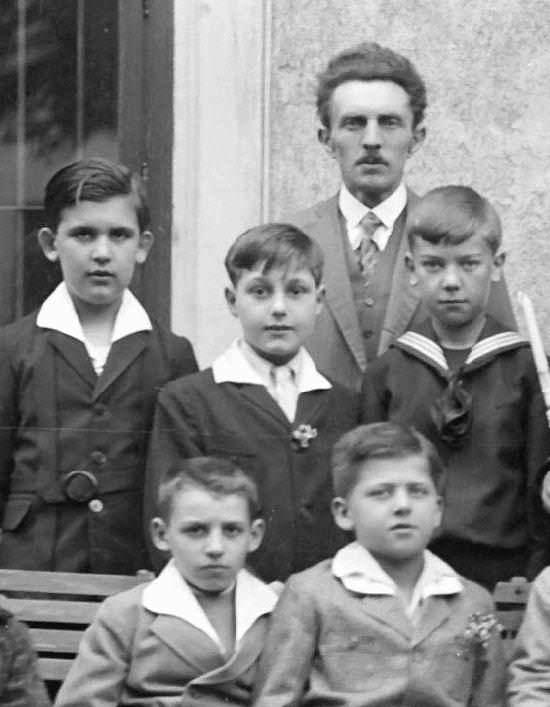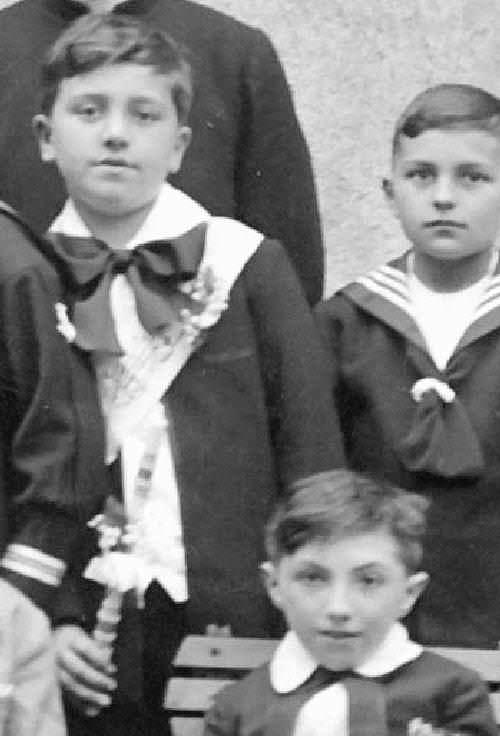
First Communion Country Trends: Germany--1920s Class Collars

Figure 1.--These German boys are having their protrait taken after their First Communion celebration. We are unsure if it is a church or school group. The image is undated, but we believe that it was probably taken in the mid-1920s. Note the wide diversity in collar styles, including open collars and a boy with an open and closed collar. There is also a boy with two open collars.
|
One of the most intreaguing aspect of this portrait is the diversity of collars show. Some are standard types, well known to HBC such as sailor collars. Other appear rather distinct. Perhaps they were popular in Germany, but we have not seen similar styles in America, England or France. Particularly puzzling is that some boys appear to be wearing outfits with two collars. Some boys do not wear shirts with collars, but rather with dickies--even some boys who are not wearing sailor suits. One boy in the back row appears to be wearing a large ronded collar, rather similar to an Eton-styled collar on his shirt with a floppy bow tie, and a plain belted jacket. The bow obsures the collar, it may be somewhat rionded rather than pointed like the classic Eton collar. He appears to have some sort of ornament or maybe flower pinned to his jacket. One boy in a formal long pants suit wears a rounded Peter Pan collar. The other boy in the formal outfit wears a very large collar, but it is difficuult to descrive as it is worn with such a large bow and there is a large dangling white ribbon that because it is the same collar as the collar makes it hard to differentiate. In sharp contrast to the boys with these formal collars are several boys with open collars. This was not common before World War I (1914-18), but reflects the trend toward more casual clothing after the War. Here it iseven seen for a First Communion service--normally a rather formal event. To make it look more formal, some boys wear their open collars with dickies. Open collars became even more popular after the War. The open collar appears to have been so stylish that one boy wore an open collar folded over his jacket lapels and another shirt and necktie underneath.
Diversity
One of the most intreaguing aspect of this portrait is the diversity of collars show. We have noted few images where the boys wear such a range of different collar styles--especially when dressing formally.
Types
Some of the collars are standard types, well known to HBC such as sailor collars. Others appear rather unique. Other appear rather distinct. Perhaps they were popular in Germany, but we have not seen similar styles in America, England or France. Particularly puzzling is that some boys appear to be wearing outfits with two collars.
Sailor collars
Several boys wear traditionally styled middy blouses with standard sailor collars.
Dickies
Some boys do not wear shirts with collars, but rather with dickies--even some boys who are not wearing sailor suits. Dickies were quite standard for sailor suirs, but we have not noted them being worn with regular suits. Note that the dickies match the suit, meaning that they were meant to be worn like that and not just an ad hoc fashion that mutter dreamed up.
Large rounded collar
One boy in the back row appears to be wearing a large ronded collar, rather similar to an Eton-styled collar on his shirt with a floppy bow tie, and a plain belted jacket. The bow obsures the collar, it may be somewhat rioynded rather than pointed like the classic Eton collar. He appears to have some sort of ornament or maybe flower pinned to his jacket.

Figure 2.--We were confused by the collar the boy stabding in the formal outfit was earing. On closer examination, he is wearing a large white collar, but not as large as we first thought. He also wears a white sash-like rivvon which crosses in front. We wonder if this was mutter's idea or if he had won some kind of competition. Notice that he is placed prominently in the photograph, in the center right by the piest.
|
Peter Pan collar
One boy in a formal long pants suit wears a rounded Peter Pan collar. He is the obly boy wearing a Peter Pan collar.
Formal white collar
The other boy in the formal outfit wears a very large collar, but it is difficuult to descrive as it is worn with such a large bow and there is a large dangling white ribbon that because it is the same collar as the collar makes it hard to differentiate. On closer examination, he is wearing a large white collar, but not as large as we first thought. He also wears a white sash-like rivvon which crosses in front. We wonder if this was mutter's idea or if he had won some kind of competition. Notice that he is placed prominently in the photograph, in the center right by the piest.
Open collars
In sharp contrast to the boys with these formal collars are several boys with open collars. This was not common before World War I (1914-18), but reflects the trend toward more casual clothing after the War. Here it iseven seen for a First Communion service--normally a rather formal event. To make it look more formal, some boys wear their open collars with dickies. Open collars became even more popular after the War. The open collar appears to have been so stylish that one boy wore an open collar folded over his jacket lapels and another shirt and necktie underneath. Equally puzzling is the boy with two open collars.
Smaller collars
Some bouys wear smaller collars which because they do not portrude out over the jackerts are not possible to describe. These boys are wearing rather modern-looking neckties.
Christopher Wagner

Navigate the Boys' Historical Clothing Web Site religious pages:
[Return to the Main German First Communion 1920s chronology page]
[Return to the Main 1020s class photograph]
[First Communion]
[Confirmation]
[Ring bearer]
[Victorian wedding]
Navigate the Boys' Historical Clothing Web Site:
[Introduction]
[Activities]
[Biographies]
[Chronology]
[Clothing styles]
[Countries]
[Bibliographies]
[Contributions]
[FAQs]
[Glossaries]
[Satellite sites]
[Tools]
[Boys' Clothing Home]
Navigate the Historic Boys' Clothing Web chronological pages:
[The 1900s]
[The 1910s]
[The 1920s]
[The 1930s]
[The 1940s]
[The 1950s]
[The 1960s]
[The 1970s]
[The 1980s]
[The 1990s]
Navigate the Historic Boys' Clothing Web style pages:
[Short pants suits]
[Blazers]
[Jackets]
[Kilts]
[Sailor suits]
[Sailor hats]
[Ring bearer/page costumes]
[Shortalls]
Created: June 13, 2002
Last edited: June 13, 2002




